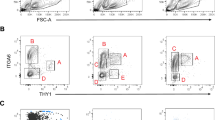Abstract
Although chicken spermatogonial stem cells (SSCs) have received considerable attention in recent years, only a few studies so far have focused on their derivation and characterization in vitro. Identification of specific molecular biomarkers and differentiation capacity of chicken SSCs would not only help us to understand cell and molecular biology of these cells, but also can contribute to their applications in biotechnology. In this regard, we found that colony-forming cells (SSCs) in newborn chicken testicular cell cultures were positive for alkaline phosphatase activity and also expressed specific markers including DAZL, STRA-8, CVH, PLZF, SPRY-1, GFRα1, GDNF, POU5F1, NANOG, GPR125, THY-1, c-KIT, and BCL6B, at mRNA level. Moreover, these cells expressed POU5F1 and GPR125 proteins as reliable intracellular and cell surface markers, respectively; whereas they were negative for SSEA-1. Furthermore, we showed that newborn chicken colony-forming cells had spermatogenesis potential and thus could be produced sperm-like cells in a three-dimensional matrix in vitro. In conclusion, this study reports novel insights into the molecular signature of newborn chicken SSCs in comparison with mammalian SSCs and for the first time we report a successful protocol for in vitro spermatogenesis and thus production of sperm-like cells from newborn chicken testicular cell cultures.







Similar content being viewed by others
References
Conrad S, Renninger M, Hennenlotter J, Wiesner T, Just L, Bonin M, Aicher W, Buhrin HJ, Mattheus U, Mack A, Wagner HJ, Minger S, Matzkies M, Reppel M, Hescheler J, Sievert KD, Stenzl A, Skutella T (2008) Generation of pluripotent stem cells from adult human testis. Nature 456:344–349
He Z, Kokkinaki M, Jiang J, Dobrinski I, Dym M (2010) Isolation, characterization, and culture of human spermatogonia. Biol Reprod 82:363–372
Hofmann MC (2008) Gdnf signaling pathways within the mammalian spermatogonial stem cell niche. Mol Cell Endocrinol 288:95–103
Huang YH, Chin CC, Ho HN, Chou CK, Shen CN, Kuo HC, Wu TJ, Wu YC, Hung YC, Chang CC, Ling TY (2009) Pluripotency of mouse spermatogonial stem cells maintained by IGF-1- dependent pathway. FASEB J 23:2076–2087
Ishii K, Kanatsu-Shinohara M, Toyokuni S, Shinohara T (2012) FGF2 mediates mouse spermatogonial stem cell self-renewal via upregulation of Etv5 and Bcl6b through MAP2K1 activation. Development 139:1734–1743
Jung JG, Lee YM, Park TS, Park SH, Lim JM, Han JY (2007) Identification, culture, and characterization of germline stem cell-like cells in chicken testes. Biol Reprod 76:173–182
Kubota H, Avarbock MR, Brinster RL (2003) Spermatogonial stem cells share some, but not all, phenotypic and functional characteristics with other stem cells. Proc Natl Acad Sci U S A 100:6487–6492
Lacham-Kaplan O (2004) In vivo and in vitro differentiation of male germ cells in the mouse. Reproduction 128:147–152
Li JJ, Lu LZ (2010) Recent progress on technologies and applications of transgenic poultry. Afr J Biotechnol 9:3481–3488
Mizrak SC, Chikhovskaya JV, Sadri-Ardekani H, van Daalen S, Korver CM, Hovingh SE, Roepers-Gajadien HL, Raya A, Fluiter K, de Reijke TM, de la Rosette JJ, Knegt AC, Belmonte JC, van der Veen F, de Rooij DG, Repping S, van Pelt A (2010) Embryonic stem cell-like cells derived from adult human testis. Hum Reprod 25:158–167
Momeni-Moghaddam M, Matin MM, Boozarpour S, Sisakhtnezhad S, Mehrjerdi HK, Farshchian M, Dastpak M, Bahrami AR (2014) A simple method for isolation, culture and in vitro maintenance of chicken spermatogonial stem cells. In Vitro Cell Dev Biol Anim 50:155–161
Naeemipour M.; Dehghani H.; Bassami M.; Bahrami A. Expression dynamics of pluripotency genes in chicken primordial germ cells before and after colonization of the genital ridges. Mol Reprod Dev; 2013
Reding SC, Stepnoski AL, Cloninger EW, Oatley JM (2010) THY1 is a conserved marker of undifferentiated spermatogonia in the pre-pubertal bull testis. Reproduction 139:893–903
Seandel M, James D, Shmelkov SV, Falciatori I, Kim J, Chavala S, Scherr DS, Zhang F, Torres R, Gale NW, Yancopoulos GD, Murphy A, Valenzuela DM, Hobbs RM, Pandolfi PP, Rafii S (2007) Generation of functional multipotent adult stem cells from GPR125+ germline progenitors. Nature 449:346–350
Vlajkovic S.; Cukuranovic R.; Bjelakovic M. D.; Stefanovic V. Possible therapeutic use of spermatogonial stem cells in the treatment of male infertility: a brief overview. Scientific World Journal 2012: 374151; 2012
Yeh JR, Nagano MC (2009) Spermatogonial stem cell biomarkers: Improved outcomes of spermatogonial transplantation in male fertility restoration? Expert Rev Mol Diagn 9:109–114
Yosypiv IV, Boh MK, Spera MA, El-Dahr SS (2008) Downregulation of Spry-1, an inhibitor of GDNF/Ret, causes angiotensin II-induced ureteric bud branching. Kidney Int 74:1287–1293
Yu F, Ding LJ, Sun GB, Sun PX, He XH, Ni LG, Li BC (2010) Transgenic sperm produced by electrotransfection and allogeneic transplantation of chicken fetal spermatogonial stem cells. Mol Reprod Dev 77:340–347
Zohni K, Zhang X, Tan SL, Chan P, Nagano MC (2012) The efficiency of male fertility restoration is dependent on the recovery kinetics of spermatogonial stem cells after cytotoxic treatment with busulfan in mice. Hum Reprod 27:44–53
Acknowledgments
The authors would like to thank Morghak Co. for generously providing the chickens. This work was supported by grants from Ferdowsi University of Mashhad (No. 20880 and No. 100313) which are highly appreciated. We are also thankful to Mrs. Fatemeh B. Rassouli and Mr. Nakhaei for their great assistance.
Conflict of interest
The authors declare no conflicts of interest.
Author information
Authors and Affiliations
Corresponding author
Additional information
Editor: T. Okamoto
Rights and permissions
About this article
Cite this article
Sisakhtnezhad, S., Bahrami, A.R., Matin, M.M. et al. The molecular signature and spermatogenesis potential of newborn chicken spermatogonial stem cells in vitro. In Vitro Cell.Dev.Biol.-Animal 51, 415–425 (2015). https://doi.org/10.1007/s11626-014-9843-1
Received:
Accepted:
Published:
Issue Date:
DOI: https://doi.org/10.1007/s11626-014-9843-1




